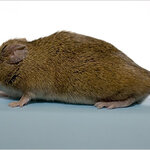Ecology & Zoology

In vertebrates with separate sexes, sex determination can be genotypic (GSD) or temperature-dependent (TSD). TSD is very common in reptiles, where the ambient temperature during sensitive periods of early development irreversibly determines whether an individual will be male or female. The number of males and females in a population is the sex ratio, a key demographic parameter crucial for population viability.
Some studies have suggested that TSD may also be very common in some species of fish, with increasing temperatures generally affecting the sex ratio of a species in one of three ways:…

The ocean is a noisy place and although we don't hear much when we stick our heads underwater, the right instruments can reveal a symphony of sound.
The noisemakers range from the low-frequency bass tones of a fish mating ritual to the roar of a motorboat. The study of how underwater animals hear is a growing topic in marine science, especially with regards to naval sonar and whales.
This summer at the Marine Biological Laboratory (MBL), zoologist T. Aran Mooney will be the first scientist to look at cephalopod hearing, using the squid, Loligo pealeii, as a model. To learn how sensitive the…
According to Peter Olson of the Natural History Museum in London, "All free-living organisms host one or more parasites." This can be taken two ways, both of them generally true: a) that each individual multicellular organism hosts at least one individual parasite within its body, and b) that each free-living species plays host to at least one species of parasite that attacks it exclusively. Consider this second point for a moment. For each free living species there is one or more (usually several more) parasite species -- that is, as a category (polyphyletic, obviously), parasites may…

Nicholas Wade has an outstanding piece in today's Times Science section about the "hope" for Resverotrol and other sirtuin-activating compounds that may activate the lifespan extending pathway controlled by caloric restriction, although, like several stories on the subject lately, it left me wondering about a few things. Comment and answers appreciated, they are:
1. The reason for these stories--a Cell Metabolism article that appeared July 3 was actually quite negative about resverotrol's lifespan-extending effects. The Cell piece was about an experiment on normal, rather than high…

Researchers in Madagascar have confirmed the existence of a population of greater bamboo lemurs more than 400 kilometers (240 miles) from the only other place where the Critically Endangered species is known to live, raising hopes for its survival.
The discovery of the distinctive lemurs with jaws powerful enough to crack giant bamboo, their favorite food, occurred in 2007 in the Torotorofotsy wetlands of east central Madagascar, which is designated a Ramsar site of international importance under the 1971 Convention on Wetlands.
Updated information on the species will be presented at the…

Research at the University of Liverpool has found how Saharan dust storms help sustain life over extensive regions of the North Atlantic Ocean.
Working aboard research vessels in the Atlantic, scientists mapped the distribution of nutrients including phosphorous and nitrogen and investigated how organisms such as phytoplankton are sustained in areas with low nutrient levels.
They found that plants are able to grow in these regions because they are able to take advantage of iron minerals in Saharan dust storms. This allows them to use organic or 'recycled' material from dead or decaying…

New research on the midshipman fish, a close relative of the toadfish, indicates that that the ability to make and respond to sound is an ancient part of the vertebrate success story.
After building a nest for his potential partner, he calls to nearby females by contracting his swim bladder, the air-filled sac fish use to maintain buoyancy. The sound he makes is not a song or a whistle, but a hum; more reminiscent of a long-winded foghorn than a ballad. Female midshipman find it very alluring, and they only approach a male's nest if he makes this call.
Midshipman fish shown inside their nest…

Researchers at Queensland University of Technology have had good results with a trial vaccine for chlamydia, a disease which is decimating koala populations in the wild.
Chlamydia in koalas was a significant cause of infertility, urinary tract infections, and inflammation in the lining of the eye that often led to blindness.
Professors Peter Timms and Ken Beagley from Queensland University of Technology's Institute of Health and Biomedical Innovation (IHBI) said the vaccinated koalas, which are at Brisbane's Lone Pine Koala Sanctuary, were mounting a good response to the vaccine.
"A good T-…

Women exposed to high levels of PCBs (polychlorinated biphenyls – a group of banned environmental pollutants) are less likely to give birth to male children, according to a study published today in Environmental Health.
The researchers found that among women from the San Francisco Bay Area, those exposed to higher levels of PCBs during the 50s and 60s, were significantly more likely to give birth to female children.
Similar exposure is thought to have occurred in Wales, after a quarry on the edge of Groesfaen village near Cardiff was used as a toxic dumping ground from 1965 to 1972.
PCBs…

Bats, outnumbered only by rodents in number of species and thus the second largest group of mammals, are a remarkable evolutionary success story. Now they have gotten even more interesting. Researchers of the Leibniz-Institute for Zoo and Wildlife Research in Berlin (Germany) and Boston University (U.S.A.) have discovered a place that harbors the highest number of bat species ever recorded.
In just a few hectares of rainforest in the Amazon basin of eastern Ecuador, they have found more than 100 species of bats.
Dr. Katja Rex and colleagues captured bats at several biodiversity hotspots…